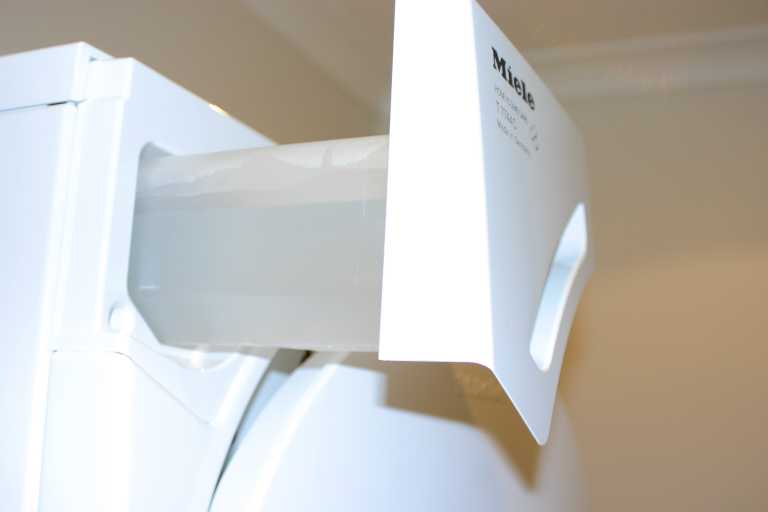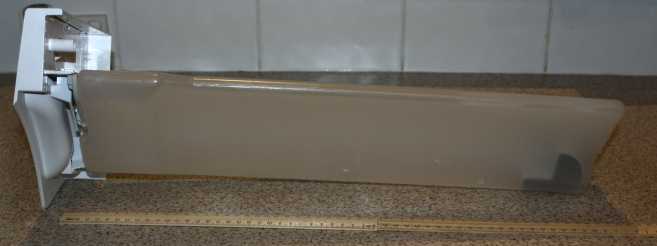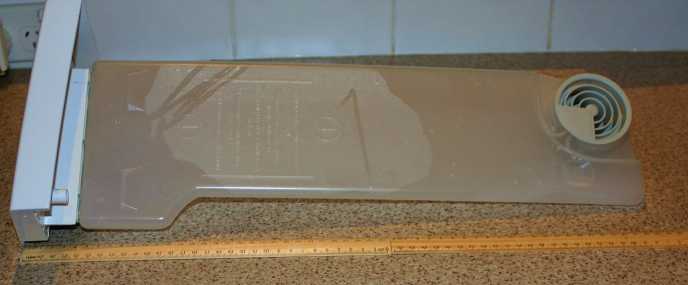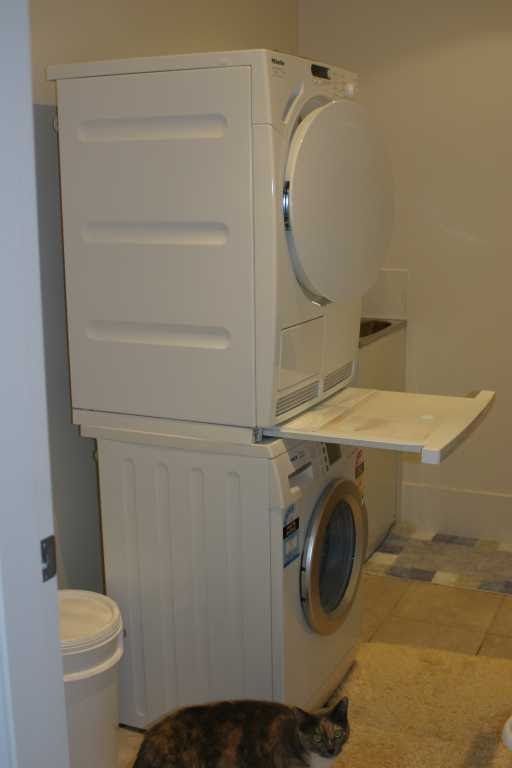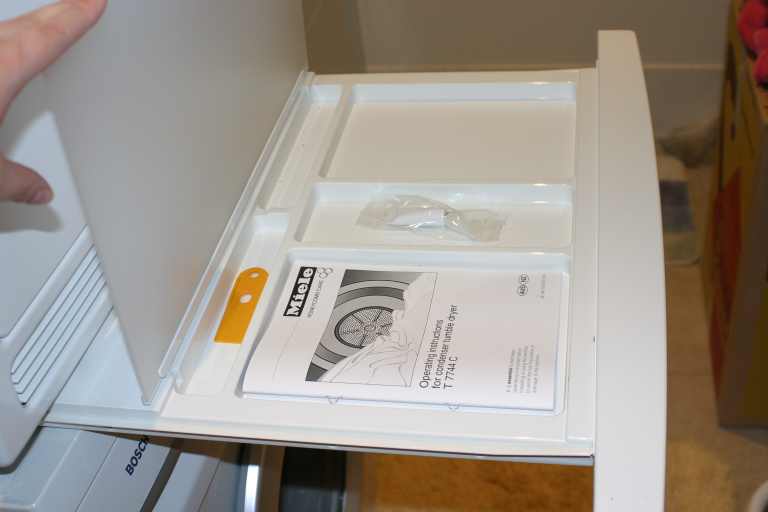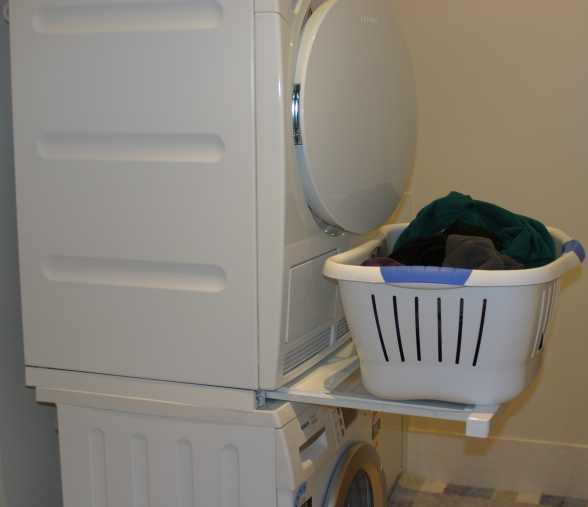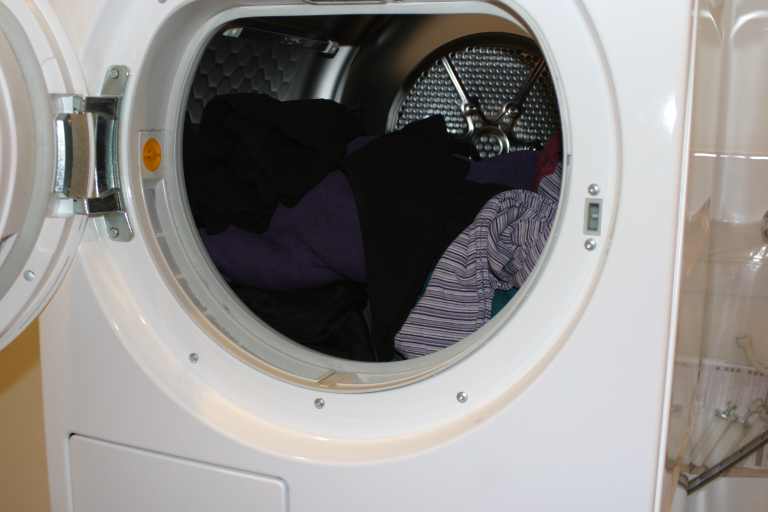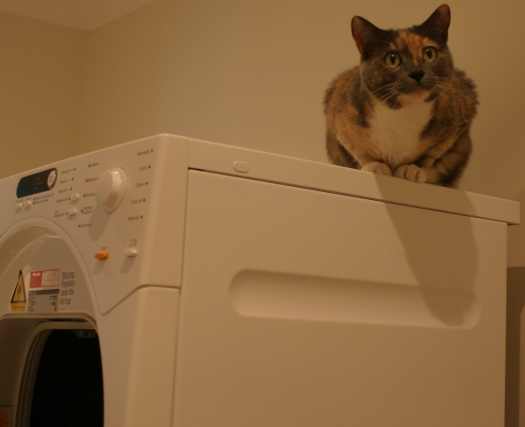Thanks everyone for all the emails asking where is the Miele post! The truth is, I was too busy using the new appliances to write about them. So what is a Condenser Dryer, how does it work, and what good is it? Pay close attention because I am about to tell you all the secrets and why it is worth buying one. Most of the images in this post can be clicked on to see a larger image.
It works by taking the moist, warm air from inside the dryer to this little unit you see below – it looks a bit like the radiator from the front of your car.
Air from the room the dryer is located in is on the other side of the fins and the difference in temperature magically makes the moisture turn into water droplets.
What Does It All Mean?
– It means the drying is done at much cooler temperatures
– Fabrics you would not normally tumble dry can be safely tumble dried
– It is less harsh on your clothes, which means they last longer
– There is no need to vent the dryer at all – in fact our dryer not have a venting kit available to purchase. I have one word of caution re this point – you may find the dryer does heat up the room it is in, especially if that room does not have a window you can open. It will not heat up to the extent it would with a regular dryer.
– There is very little lint produced
– You get some water back which you can use to water your plants.
– You do not have moisture and lint covering your walls – you can sometimes get that with a normal dryer if you don’t have it vented.
Where Does The Water Go?
You have a few choices with the Miele – you can choose to drain the water down the sink – you can choose to have it drain into a bucket – you can choose to have it collect in the water reservoir shown below.
The water reservoir is actually quite large. Here’s a couple of pics of it pulled out and on my kitchen counter.
Each load in the machine produces between 2-3 litres of water. If the reservoir fills up before the load is done, the machine beeps until you arrive to empty it.
The Stacking Kit –
If you have a front load washing machine, Miele’s stacking kit will generally fit on top of most other washers. The stacking kit includes a pop out tray, to make it easier to load the dryer.
Oh look, a kitty snuck into that pic! The pop out tray includes a waterproof space for your washer and dryer instruction manuals. How sweet is that?
Here you can see a load of washing waiting to go into the dryer.
Why Use A Dryer?
I think I mentioned this once before but in Australia we have some nasty creatures called spiders, who tend to like clotheslines a lot. When I first moved in with The Other Half, we had washed our quilt cover and hung it on the line.For the next two weeks both of us would wake up with what looked like mosquito bites but we could never find any mosquitos. It was odd, because it looked like a trail of bites. I’m itching just typing about it.
A small spider, a very close cousin of the White Tail Spider, had crawled inside our quilt cover without our knowing it. One morning I saw it crawl out of the quilt cover and it just sat there looking at me, seeming quite pleased with itself.I was looking for something to dead it with and thanking all the deities it was not a white tail because those can give some very nasty bites where your skin peels away.. Once it was squashed I swore we would never hang anything out on the clothesline again. And we never have.
What About Energy Use?
We use Origin Energy’s 100% wind power product. That means I pay a little bit more per kilowatt of electricity. Origin then purchases the amount of kilowatt hours I use from wind power.
Why Wind?
I’ve personally seen the wind farms in action and I liked what I saw. I believe in all forms of green energy and I also like solar quite a bit. You can choose solar as an option also.
How Much To Go Green?
Depending on where you are green electricity may cost you as little as $1 extra per week – I recommend you give Origin a call, or talk to your current electricity company if you are interested in going green. The more of us who switch to green, the better.
Because I Use Green –
I don’t feel as guilty about how much power we use. Of course I do try to cut back usage everywhere we can by using power saving globes and turning things off when we’re not using them.
No Dryer Gets A Good Energy Rating
The best energy rating for a dryer that I have seen is a 3.5 star. Most people are completely baffled by the energy ratings and it is no wonder, because the way they measure them is very complicated. Dryers all use electricity. There is no getting around that. If you want to reduce your greenhouse gas emissions and use a dryer, your best choice is to choose green electricity.Your second best choice is to choose an “auto sensing” dryer rather than a timer model, because these will stop drying once the clothes are dry.
How Much Is A Condenser Dryer?
Are you sitting down? You might need to be. These are not cheap to buy. However, they will last 3-4 lifetimes of a normal dryer, they give us water deprived Aussies the chance to get some of the water back from our washing, and they do increase the lifespan of your clothes. Condenser dryers are generally $1500AUD or more to purchase. The Miele is available at $1799, unless you purchase it with a front load washer, in which case it is $1499.
As With All Purchases Snoskred Makes –
I’ve done my research thoroughly before I buy anything, and because I worked in this industry I know this product is worth the money. These machines are some of the last 20 year lifespan products available on the market.
Why Do We Have A Bosch Front Load Washing Machine?
The Other Half built our front loader himself on a visit to the Bosch factory in Thailand just over a year ago. It was then packed up and shipped to us here. He did quite a good job because it is still working. ;) Otherwise we would have purchased ourselves a Miele.
Any Questions, Thoughts, Comments?
The comments section is closed because this post was written in 2007. You can always use the Contact Form to reach me if there is anything I didn’t explain clearly, or anything you want to know more about? Click here for the contact form.
Update January 2015
It is just over 7 years since we first got our Miele condensing dryer. The dryer is still going strong and we are still just as happy with it as when we first purchased it.
The biggest benefit for us has been the extension in the life of our clothes, especially clothes that you can’t normally dry in a dryer. I have a lot of outfits with sequins, beading, and glitter. I always wash these clothes inside out to prevent any of the sequins or beads getting caught on another piece of clothing.
I dry them on the low temperature setting. They come out of the dryer just as gorgeous as when I first bought them, and I know these clothes could not be dried in a regular dryer at all.
Update August 2015 –
A reader of this post sent me an email with some questions, in particular about sharing an office with one of these units. I thought I would put my answers here, in case anyone else is having the same questions.
Your post seems to indicate that these dryer CAN be vented. Is that the case?
I’ve checked with my other half who used to sell them – our dryer does not have a venting kit available and it cannot be vented.. I’m going to have to go back and re-read my post to see what I’ve said and fix that if I’ve said the wrong thing. Each brand and model are different – you might find one that does have a venting kit but the Mieles do not, though some of the models if you got creative you might be able to “create” one.
I noticed you said they give off heat into the room. Can you give me an idea as to how hot the room might get?
Our laundry at present is quite a cold room and the dryer does give off enough heat that it warms up quite nicely. If you were working in the same room you would want some air flow I think. A fan might do the job. In winter time if it gets very cold where you are, you might find this unit does a decent heating job.
More annoying than any heat would be the noise. If I had to work in the same room with it, I’d want noise cancelling headphones. It is like a constant whirring sound, and regularly, it stops and reverses. To me the stopping and reversing is the most annoying par
Does the dryer give off moisture? I know you say it isn’t like a normal dryer unvented (where you would have moisture and lint all over), but is the air coming off the dryer moist or actually dry?
The dryer does not give off any moisture at all. All the moisture is condensed internally. The only lint in our laundry room is what we remove from the machine when it is finished drying.
Lastly, I’m not sure how the weather is by you, but I am wondering what might happen if you need to run the dryer in the summer if the air in the room might be hot and might have some humidity. Would the dryer not work well?
I live in Australia. Our hottest summer days are 40 degrees C which is 104F, and we can have those hot days every single day for 2-3 weeks or a month at a time, plus, being coastal, humidity can get quite high here. The dryer works just as well in the summer as it does in the winter and I want to make it clear that we never dry our clothes in any other way because clotheslines = spiders here, so we use the dryer all year round.
The air in the room does not really seem to get much hotter in summer, but I am thinking this is because that room is in the middle of the house on the shadow side, so it gets no warmth from any location other than the temperature of the air.
These dryers were originally invented for the European markets where all the appliances live in the kitchen, plus there you generally don’t mind a little heat added to the room, especially in winter, but even in summer it does not get hot there like it gets here.
All condenser dryers work on the same concept, not all condenser dryers have the same quality, and not all the dryers can have the condensed water drained out by a hose like our Miele can.
If you have to share an office with a dryer, the humidity from a regular dryer would be terrible, so a condenser is probably the only way to go.
